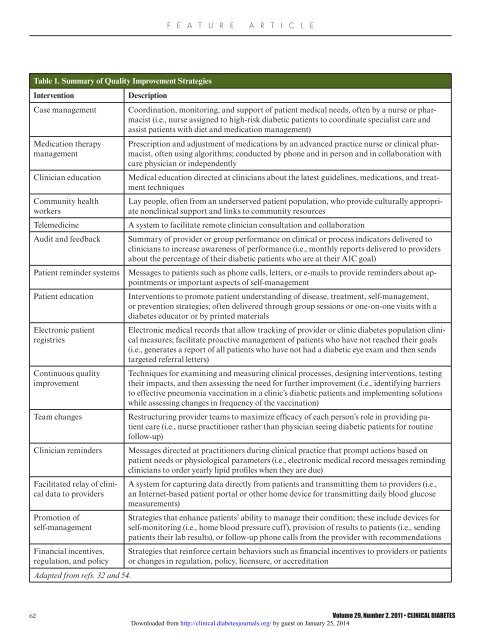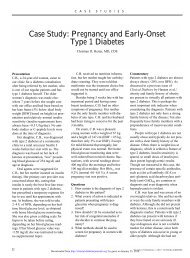Interdisciplinary Team Care for Diabetic Patients ... - Clinical Diabetes
Interdisciplinary Team Care for Diabetic Patients ... - Clinical Diabetes
Interdisciplinary Team Care for Diabetic Patients ... - Clinical Diabetes
You also want an ePaper? Increase the reach of your titles
YUMPU automatically turns print PDFs into web optimized ePapers that Google loves.
F E A T U R E A R T I C L E<br />
Table 1. Summary of Quality Improvement Strategies<br />
Intervention<br />
Description<br />
Case management Coordination, monitoring, and support of patient medical needs, often by a nurse or pharmacist<br />
(i.e., nurse assigned to high-risk diabetic patients to coordinate specialist care and<br />
assist patients with diet and medication management)<br />
Medication therapy<br />
management<br />
Clinician education<br />
Community health<br />
workers<br />
Telemedicine<br />
Audit and feedback<br />
Patient reminder systems<br />
Patient education<br />
Electronic patient<br />
registries<br />
Continuous quality<br />
improvement<br />
<strong>Team</strong> changes<br />
Clinician reminders<br />
Facilitated relay of clinical<br />
data to providers<br />
Promotion of<br />
self-management<br />
Financial incentives,<br />
regulation, and policy<br />
Adapted from refs. 32 and 54.<br />
Prescription and adjustment of medications by an advanced practice nurse or clinical pharmacist,<br />
often using algorithms; conducted by phone and in person and in collaboration with<br />
care physician or independently<br />
Medical education directed at clinicians about the latest guidelines, medications, and treatment<br />
techniques<br />
Lay people, often from an underserved patient population, who provide culturally appropriate<br />
nonclinical support and links to community resources<br />
A system to facilitate remote clinician consultation and collaboration<br />
Summary of provider or group per<strong>for</strong>mance on clinical or process indicators delivered to<br />
clinicians to increase awareness of per<strong>for</strong>mance (i.e., monthly reports delivered to providers<br />
about the percentage of their diabetic patients who are at their A1C goal)<br />
Messages to patients such as phone calls, letters, or e-mails to provide reminders about appointments<br />
or important aspects of self-management<br />
Interventions to promote patient understanding of disease, treatment, self-management,<br />
or prevention strategies; often delivered through group sessions or one-on-one visits with a<br />
diabetes educator or by printed materials<br />
Electronic medical records that allow tracking of provider or clinic diabetes population clinical<br />
measures; facilitate proactive management of patients who have not reached their goals<br />
(i.e., generates a report of all patients who have not had a diabetic eye exam and then sends<br />
targeted referral letters)<br />
Techniques <strong>for</strong> examining and measuring clinical processes, designing interventions, testing<br />
their impacts, and then assessing the need <strong>for</strong> further improvement (i.e., identifying barriers<br />
to effective pneumonia vaccination in a clinic’s diabetic patients and implementing solutions<br />
while assessing changes in frequency of the vaccination)<br />
Restructuring provider teams to maximize efficacy of each person’s role in providing patient<br />
care (i.e., nurse practitioner rather than physician seeing diabetic patients <strong>for</strong> routine<br />
follow-up)<br />
Messages directed at practitioners during clinical practice that prompt actions based on<br />
patient needs or physiological parameters (i.e., electronic medical record messages reminding<br />
clinicians to order yearly lipid profiles when they are due)<br />
A system <strong>for</strong> capturing data directly from patients and transmitting them to providers (i.e.,<br />
an Internet-based patient portal or other home device <strong>for</strong> transmitting daily blood glucose<br />
measurements)<br />
Strategies that enhance patients’ ability to manage their condition; these include devices <strong>for</strong><br />
self-monitoring (i.e., home blood pressure cuff), provision of results to patients (i.e., sending<br />
patients their lab results), or follow-up phone calls from the provider with recommendations<br />
Strategies that rein<strong>for</strong>ce certain behaviors such as financial incentives to providers or patients<br />
or changes in regulation, policy, licensure, or accreditation<br />
62 Volume 29, Number 2, 2011 • CLINICAL DIABETES<br />
Downloaded from http://clinical.diabetesjournals.org/ by guest on January 25, 2014




